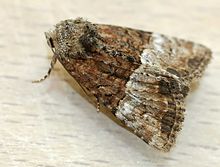Mesoligia furuncula, the cloaked minor, is a moth of the family Noctuoidea. It is found in the Palearctic realm (Europe, northwest Africa, Russia, Siberia, Japan, north Iran, Afghanistan, and China (Qinghai and Shaanxi).
| Mesoligia furuncula | |
|---|---|

| |
| Scientific classification | |
| Domain: | Eukaryota |
| Kingdom: | Animalia |
| Phylum: | Arthropoda |
| Class: | Insecta |
| Order: | Lepidoptera |
| Superfamily: | Noctuoidea |
| Family: | Noctuidae |
| Genus: | Mesoligia |
| Species: | M. furuncula
|
| Binomial name | |
| Mesoligia furuncula (Denis & Schiffermüller, 1775)
| |
Description
editThe wingspan is 22–28 mm. The length of the forewings is 10–12 mm. The typical form has the forewing sharply demarcated between a pale distal field and a rufous basal field. The colour and pattern is highly variable and furuncula may look like a lot of the species in the genus Oligia which can be separated by from all but Mesoligia literosa by details of the genitalia. A study of the genitalia of European and Asian specimens of the two Mesoligia species literosa Haworth and furuncula Denis & Schiffermüller showed however that there is no significant intra-specific variation, in these two closely related Oligia species.[1][2]
Biology
editThe moth flies in one generation from late June to mid September [2].
The larvae feed on various grasses such as Tufted Hair-grass, Festuca ovina, and Arrhenatherum elatius.[3]
Notes
edit- ^ The flight season refers to Belgium and The Netherlands. This may vary in other parts of the range.
References
edit- ^ von L. Rezbanyai-Reser Genitalmorphologische Befunde mittaxonomischen Bemerkungen bei Mesoligia literosa Haw. und furuncula D. & Sch. in Europa und in Asien, sowie weitere Angaben zu den asiatischen Oligia-Arten (Lepidoptera: Noctuidae).Entomologische Berichte Luzern 40 (1998): S. 109-142 [1]
- ^ Alberto Zilli, László Ronkay, Michael Fibiger: Apameini. In: W. G. Tremewan (Hrsg.): Noctuidae Europaeae. 1. Auflage. Band 8. Entomological Press, Sorø 2005, ISBN 87-89430-09-3
- ^ "Robinson, G. S., P. R. Ackery, I. J. Kitching, G. W. Beccaloni & L. M. Hernández, 2010. HOSTS – A Database of the World's Lepidopteran Hostplants. Natural History Museum, London".
External links
edit- Cloaked Minor at UKmoths
- Funet Taxonomy
- Lepiforum.de Includes photograph of genitalia
- Vlindernet.nl (in Dutch)